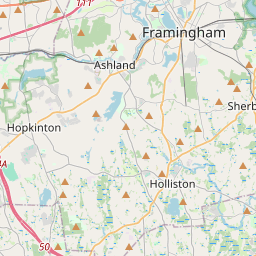Ponkapoag Plantation
Historical marker location:
2496 Washington Street, Canton, Massachusetts
( Marker is on Washington Street (Massachusetts Route 138).)
Marker installed: 1930







© OpenStreetMap contributors
1630 - 1930
Loading...
Searching for other points of interest within 3 miles of this location.The Great Boston Fire of 1872 was one of the most destructive fires in American history. It destroyed 65 acres of downtown Boston, including 776 buildings and caused $73.5 million in damage (equivalent to over $1.5 billion today).
About Norfolk County
Norfolk County Timeline
Norfolk County, Massachusetts, has a rich history that dates back to its founding in 1793. The area was initially settled by Native American tribes, specifically the Massachusett tribe, whose name the state also derived from. However, in the early 17th century, European colonists began to arrive in the region, bringing about significant changes.
In the 1630s, English settlers established the town of Dedham, which would become the first town within what is now Norfolk County. The town served as a political and administrative center for the surrounding area. Over time, more towns were established, including Wrentham, Franklin, and Stoughton, leading to the county's official formation in 1793.
Norfolk County played a significant role during the American Revolution. Many residents actively participated in the war effort, with some joining the Continental Army and others serving as Minutemen. The county was also the site of important engagements, such as the Battle of Bunker Hill in nearby Charlestown.
During the 19th century, Norfolk County underwent various changes and developments. The region was primarily agrarian, with farming and manufacturing being the primary industries. However, with the growth of urban areas like Boston, Norfolk County began to experience suburbanization. Improved transportation infrastructure, such as the construction of railroads, facilitated commuting between the county and the city.
Today, Norfolk County continues to thrive as a suburban area with a diverse economy. It is home to a range of industries, including healthcare, education, technology, and finance. The county also boasts numerous parks, recreational areas, and historical sites, attracting both residents and visitors alike.
In the 1630s, English settlers established the town of Dedham, which would become the first town within what is now Norfolk County. The town served as a political and administrative center for the surrounding area. Over time, more towns were established, including Wrentham, Franklin, and Stoughton, leading to the county's official formation in 1793.
Norfolk County played a significant role during the American Revolution. Many residents actively participated in the war effort, with some joining the Continental Army and others serving as Minutemen. The county was also the site of important engagements, such as the Battle of Bunker Hill in nearby Charlestown.
During the 19th century, Norfolk County underwent various changes and developments. The region was primarily agrarian, with farming and manufacturing being the primary industries. However, with the growth of urban areas like Boston, Norfolk County began to experience suburbanization. Improved transportation infrastructure, such as the construction of railroads, facilitated commuting between the county and the city.
Today, Norfolk County continues to thrive as a suburban area with a diverse economy. It is home to a range of industries, including healthcare, education, technology, and finance. The county also boasts numerous parks, recreational areas, and historical sites, attracting both residents and visitors alike.
Norfolk County Timeline
This timeline provides a condensed summary of the historical journey of Norfolk County, Massachusetts.
- 1679 - Norfolk County is established by the Massachusetts Bay Colony
- 1700s - Towns within Norfolk County begin to develop and grow
- 1775-1783 - Norfolk County residents actively participate in the American Revolutionary War
- 1793 - The Norfolk County Court House is built in Dedham
- 1801 - Weymouth becomes the first town to separate from Norfolk County
- 1822 - Quincy separates from Norfolk County
- 1845 - Norfolk County experiences significant population growth due to industrialization
- 1863-1865 - Many Norfolk County residents served in the American Civil War
- 1915 - The Blue Hills Reservation is established, providing recreational opportunities for residents
- 1956 - The Massachusetts Turnpike is extended through Norfolk County, improving transportation
- Present - Norfolk County continues to be a vibrant area with a diverse economy and rich history